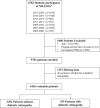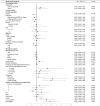Associations between psycho-behavioral risk factors and diabetic retinopathy: NHANES (2005-2018)
- PMID: 36187629
- PMCID: PMC9521717
- DOI: 10.3389/fpubh.2022.966714
Associations between psycho-behavioral risk factors and diabetic retinopathy: NHANES (2005-2018)
Abstract
Introduction: Diabetes mellitus (DM) and diabetic retinopathy (DR) increase the global burden. Since their pathogenesis is complex, it is necessary to use the biopsychosocial model to discover the most effective strategies. The study is aimed to investigate the psycho-behavioral factors of DR and confirm the discrepancies from previous studies.
Research design and methods: The study comprised seven cycles of cross-sectional data of the National Health and Nutrition Examination Survey (NHANES) from 2005-2006 to 2017-2018. Samples of DM were selected from this complex multi-stage probability sample and divided into the non-DR and DR groups, where 4,426 samples represented 18,990,825 individuals after weighting. This study comprehensively explored the biological, social, and psychological risk factors of DR, among which the biological factors included blood pressure, blood routine, HbA1c%, blood glucose, the duration of DM, family history, comorbidities, and treatment methods. Social aspects include gender, education, income, insurance, smoking, drinking, sleep habits, and recreational activities. The Patient Health Questionnaire-9 (PHQ-9) was used to assess the psychological state. Taylor series regression was used to examine the connection between factors and DR.
Results: Men accounted for 55.5% of the DR group (P = 0.0174). Lymphocyte count, insulin treatment, heart failure, stroke, liver condition, and renal failure showed significant differences in DR (P < 0.05). The incidence of depression in DR was 40.5%. Mild to moderate depression [odds ratio was associated with DR [(OR) = 1.37, 95% confidence interval (CI): 1.06-1.79], but there was no statistical difference in severe depression (OR = 1.34, 95% CI: 0.83-2.17). Although ≤ 6 h of sleep was associated with DR (OR = 1.38, 95% CI: 1.01-1.88), we found no statistical differences in alcohol consumption, recreational activities, or sedentary time between the two groups in our current study (P > 0.05).
Conclusions: The biological risk factors of DR are significant. It showed that stroke is associated with DR, and retinal exams have the potential value as a screening tool for the brain. Besides, psycho-behavioral risk factors of DR should also be paid attention. Our study highlights that mild and moderate depression and ≤6 h of sleep are distinguishably associated with DM complicated with DR. It indicates that psycho-behavioral risk factors confer a vital influence on diabetic health care and DR.
Keywords: NHANES; depression; diabetic retinopathy; recreational activity; sleep duration.
Copyright © 2022 Sun, Zhang, Guo, Zhou, Niu, Wang and Dou.
Conflict of interest statement
The authors declare that the research was conducted in the absence of any commercial or financial relationships that could be construed as a potential conflict of interest.
Figures



References
-
- The Diabetic Retinopathy Barometer Report Global Findings International Federation on Ageing, International Agency for the Prevention of Blindness, International Diabetes Federation. (2020). Available online at: https://idf.org/our-activities/care-prevention/eye-health/dr-barometer.html. (accessed June 30, 2021).
Publication types
MeSH terms
Substances
LinkOut - more resources
Full Text Sources
Medical

